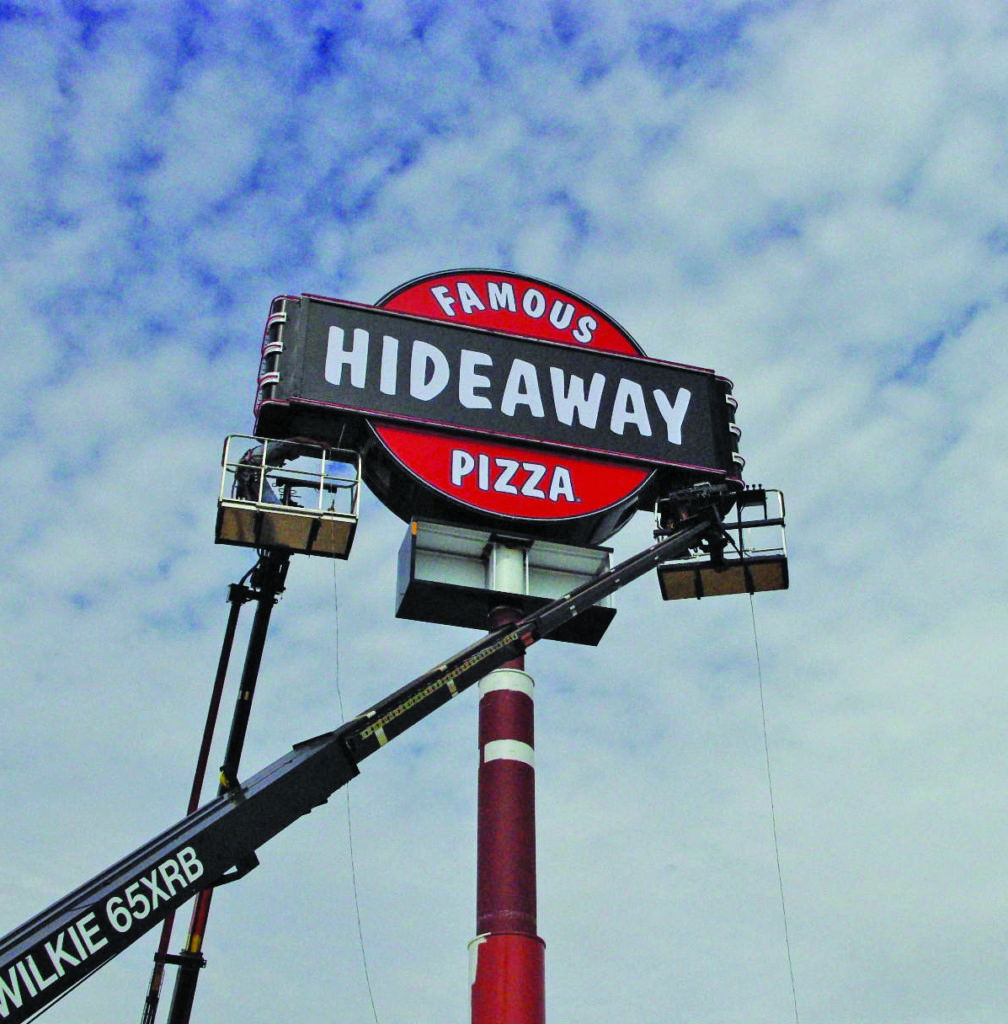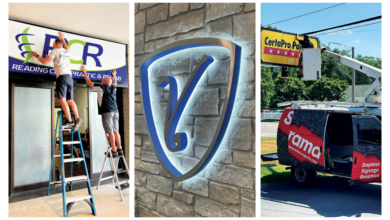
Customizing the perfect lift truck for your installation business is a big-ticket expenditure, but a changing landscape of rules and regulations has many sign shops reconsidering large-scale equipment. Here’s what to look for (and look out for) when shopping for a lift truck.
Aside from wide-format printing equipment, one of the highest capital costs a small sign shop faces is the decision to invest in a new lift or crane truck, allowing them the ability to more easily install and service billboard, platform, or building-mounted signage.
Changes in state and federal regulations concerning lift trucks, not to mention changes to signage itself, have precipitated some rethinking for manufacturers and customers. However, plenty of options are still available.
John Glazer, executive vice president of Omaha, Nebraska-based Elliott Equipment Company, says there has been more of a push in recent years to offer lift truck equipment that does not require a commercial driver’s license (CDL) to operate—allowing more members of your team to operate the truck or bucket legally. Glazer says this includes a range of models that can reach up to 87′.

“But there are also new NCCCO regulations that require Crane Operator Certification for any aerial with lifting capacity greater than 2,000 pounds, which is making it harder for companies to find qualified operators,” he adds. These rules apply to anyone helping to rig up the load or even giving signals to the operator. Elliott has responded with equipment with appropriate lifting capacity, and the company can also work with users to re-rate their machine’s capacity below the federal limit. And Glazer says the changes don’t end there.
“OSHA also changed its rules with regard to handling people with cranes, so users should be aware of machines built after 2010 that carry both an ANSI A92.2 (aerial) and ASME B30.5 (crane) designation,” Glazer explains. “These dual-rated machines may require a trial lift and proof test be performed prior to lifting personnel.”
Bryan Wilkerson, the vice president with Oklahoma City’s Wilkie Manufacturing, says he sees a gradual move away from larger cranes and lifts, not just because of regulations.
“This has been a slow change over the years with municipalities moving the height as well as the size (of signage) a bit lower and smaller each year, so the need for 85-foot-plus equipment is shrinking,” he says. “Signs have also gotten a lot lighter, as most are made from aluminum and plastic or flex faces with LEDs and low-watt transformers.”
Wilkerson says those changes helped prompt the development of Wilkie’s XRB and XLR family of remote service cranes, which can provide similar building and pole access to installers with smaller-scale equipment.
Other recent industry changes, Wilkie notes, include drastically intensified cab maintenance schedule regiments, part of federal and state emissions requirements. And more than just certification issues, companies are embracing the reality that fewer and fewer employees know how to drive a manual transmission, so automatic transmissions on lift trucks have become more popular.
What other features and capabilities should you be looking for in a lift truck? Glazer says it is critical to make sure the vehicle is set up to have and use tools at the lift platform, allowing users the ability to conduct any drilling, electrical, or advanced modification for an install job, as well as run air or a pressure washer to installation height, or test an elevated sign before the main power is connected.
“Whether it be 110-volt outlets, welders, oxy/acetylene, or others, having the dedicated circuits in the platform saves time and increases net capacity,” he says. “The ability to have a job that stows in the platform and can deploy with minimal assembly is also a significant time-saver.”
Wilkerson adds that ease of operator access is also an important attribute.
“Must-have options for new equipment should include a two-man bucket with remotes in the basket; front-entry baskets are very nice for working on a double-sided message board or signs with a catwalk so that the operator can step directly out of the basket, and rotating baskets are great for working long wall fronts and staying parallel to the wall,” he says.
Other niceties depend on the kind of installation work you plan on doing but can certainly come in handy, Wilkerson adds.
“Face rests for handling large faces are also great in service and installation jobs, and a jib winch or lifting arm in the basket will make installing channel letters and awnings much easier,” he explains. An easy one that anyone can add to the crane is a small magnetic tray to hold the small metal tek screws when they are removed to do a service.”
And whether you are a fan of Ford, Ram, GM, or heavy-duty truck manufacturers including International, Kenworth, and Freightliner, both companies say they’ll work with users to provide or mount lift equipment on any brand of chassis they desire, provided it meets the Gross Vehicle Weight Rating and frame rail standards.
Wilkerson says the platform and truck body decision largely depends on how big you plan to go with your installation capacity.
“The bed and body options can vary with the type of jobs you are going to put the truck on, such as ladder trucks, side stake pockets, tie-down strap and anchor points, plus the type and size of boxes you plan to carry,” he adds. “Will you be carrying 8′ and 10′ fluorescent lamps? Do you need a storage spot for large banners? Will you need racks for long poles or additional toolboxes for ballasts or transformers?”
For 2020, Elliott says the biggest innovations in lift trucks have come in next-generation control technology.
“This includes a touchscreen at the platform, which shows important status and diagnostic information and allows the user to remotely interact with our technicians to modify operating ranges and troubleshoot equipment through an app on their phones,” he explains.



